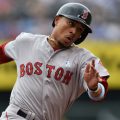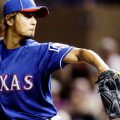This article is one in a series that uses the FantasyLabs Tools to build daily fantasy scouting reports for MLB lineups.
The Toronto Blue Jays had a pretty dramatic and criticized offseason. Between the ‘take it or leave it’ offer to Edwin Encarnacion and the length of time it took to bring Jose Bautista back, there was always something going on. In the end, Edwin signed elsewhere for less than the Jays offered, and Bautista signed for a much smaller and shorter deal than most people imagined he would.
New to the team are Kendrys Morales and Steve Pearce, who are expected to platoon at designated hitter and first base. Pearce may also see some time in the outfield or perhaps second base as the team moves him around. It will be intriguing to see how the post-Edwin era of the Blue Jays goes.
2016 Blue Jays

Using our Trends tool, I screened for the nine Blue Jays used most commonly last season. The team had a +0.18 FanDuel Plus/Minus with a 38.3 percent Consistency Rating. These numbers aren’t great, but they slightly exceed expectation.
Of course, the Blue Jays lost two pretty significant bats this offseason in Encarnacion and Michael Saunders:

While Saunders tailed off a bit at the end of the season, the Jays will miss their collective +0.51 Plus/Minus as they try to come up with solutions to make up for their lost power.
New Blue Jays
The Jays are likely hoping that Morales — a switch hitter coming off the second-best home run season of his career — and Pearce will be able to replace what Edwin and Saunders did last season.
While the two departing Blue Jays outproduced Morales and Pearce last year by 1.42 FanDuel points per game, the new arrivals still exceeded their expectations with a comparable +0.50 Plus/Minus.

From a DFS perspective, Morales and Pearce might be able to hold their own.
Home/Road
Here’s how the nine most-frequent Blue Jay batters produced at home compared to on the road in the 2016 season:

As one would expect from a team playing in one of the more hitter-friendly stadiums, the Blue Jays were significantly better at home than on the road, with a higher Plus/Minus, Consistency, and Upside.
Struggling Stadiums

Of the six stadiums in which the Blue Jays struggled the most last year, three of them belong to division opponents. Tropicana Park is known to benefit pitchers, but Yankee Stadium and Fenway Park are both hitter-friendly fields (Yankee Stadium more for lefties and Fenway more for righties). Given that Saunders was the team’s only permanent lefty and Justin Smoak is an uncertain switch hitter, it makes some sense that the Blue Jays would struggle at Yankee Stadium.
When facing right-handed pitchers, the switch-hitting Morales could potentially replace the production of Saunders.
New Jays in the American League East
Pearce has spent each of the past five seasons inside the AL East while Morales has spent his entire career in the AL. They have both played their fair share of games in AL East stadiums:

With the exception of Fenway, none of the AL East stadiums have particularly troubled the two new Blue Jays. Their success at Tropicana Field is particularly notable, considering how unfriendly the park traditionally has been to hitters.
Kendrys Morales

One of the biggest criticisms of the Jays is their lack of left-handed hitters. Bringing in the switch-hitting Morales, they have theoretically improved in this regard, but last year Morales was much more successful from the right side of the plate.
Based on his numbers against left-handed pitchers (.392 wOBA, .231 ISO, and 147 wRC+) and right-handed pitchers (.314 wOBA, .191 ISO and 93 wRC+), Morales was clearly more dominant against lefties last year. At the same time, the Jays mash right-handed pitchers — despite all of their righties — so having a batter who can hit lefties as well as Morales can isn’t necessarily suboptimal for the team.
Morales in the Rogers Centre is going to be intriguing. The spray chart on the left is with the Kauffman Stadium layout; the right, the Rogers Centre:

There were numerous doubles and flyouts at Kauffman that have a good chance of turning into home runs in Toronto. Additionally, Morales will now play divisional games in Yankee Stadium, where the short porch in right field should benefit him when he faces righties.
Steve Pearce

Pearce is another player likely intended to help the Jays against lefties. A righty, Pearce has rather extreme splits based on the handedness of pitchers. Last season he put up an elite .428 wOBA, .305 ISO, and 176 wRC+ against southpaws.
At the same time, Pearce does have a 21.1 percent strikeout rate against lefties, perhaps because he is selling out for power, and he’s not likely to bat in the top half of the order. On the one hand, his presence does make the lineup even deeper with HR potential. On the other hand, the Jays arguably don’t need more power, as last season they were fourth in the majors with 221 HRs.
Handedness
The Blue Jays are a fascinating group of hitters. The team is made up primarily of right-handed hitters, and their lefties are relied upon a lot less. In the following trend, I have included Morales and Pearce instead of Edwin and Saunders so we can see how the current team hit lefties and righties last season:

Almost a full point better against righties, this righty-heavy team of power hitters defies the standard splits:

The Blue Jays against left-handed pitchers were pretty bad last year, with the only three positive Plus/Minus values belonging to the two switch hitters (Morales and Smoak) and a righty specialist who crushes lefties and is new to the team (Pearce).
Against right-handed pitchers, almost all of the team’s top hitters had a positive Plus/Minus. Bautista was the only significant Blue Jay last season with a negative Plus/Minus against right-handed pitching — and that was due to his salary: His average of 11.38 FanDuel points per game was good for second in the trend cohort.
Pitcher Types
With great power comes an increased strikeout rate. The Blue Jays had the eighth-highest strikeout rate in the majors at 21.9 percent last year.

Despite how much the Blue Jays struck out, they were still a relatively successful team against high-strikeout pitchers. When taking on a pitcher in the top quartile of strikeouts per nine innings, the current Blue Jays had a +1.48 Plus/Minus with 44.2 percent Consistency.
Hard-throwing pitchers gave the Jays a bit of trouble last season.

While they still have a +0.06 Plus/Minus, that is nothing special, and their 36.2 Consistency in this situation is lower than what we typically see from most positive trends.
On a player level, Josh Donaldson has hit the four-seam fastball particularly well, hitting 0.08 HR/AB with a .725 slugging percentage. Morales has similar numbers against the four-seam fastball with 0.08 HR/AB and a .545 slugging percentage.
The Jays also have a bunch of hitters who are very good against the slider. Russell Martin and Troy Tulowitzki are slider specialists who average 0.07 HR/AB with a .448 and .500 slugging percentage, and Bautista hits 0.08 HR/AB with a .444 slugging percentage. If the Jays face a pitcher who’s primary or secondary pitch is the slider, they could offer an intriguing mini-stack.
Conclusion
The Blue Jays have some question marks as they enter the season. Losing the power threat of Encarnacion and — to a lesser extent — Saunders could ultimately prevent them from making the playoffs for a third straight year. The additions, however, of Morales and Pearce should help mitigate that loss.
The Blue Jays have had one of the league’s best lineups for a while, and within our Player Models you use our stacking tool and Lineup Builder to create multiple rosters that feature variations of a team stack. Without Encarnacion, the Jays may experience some early-season fade until DFS players have a stronger sense of the team’s capabilities. Pro subscribers should monitor their early-season ownership via our DFS Ownership Dashboard.





